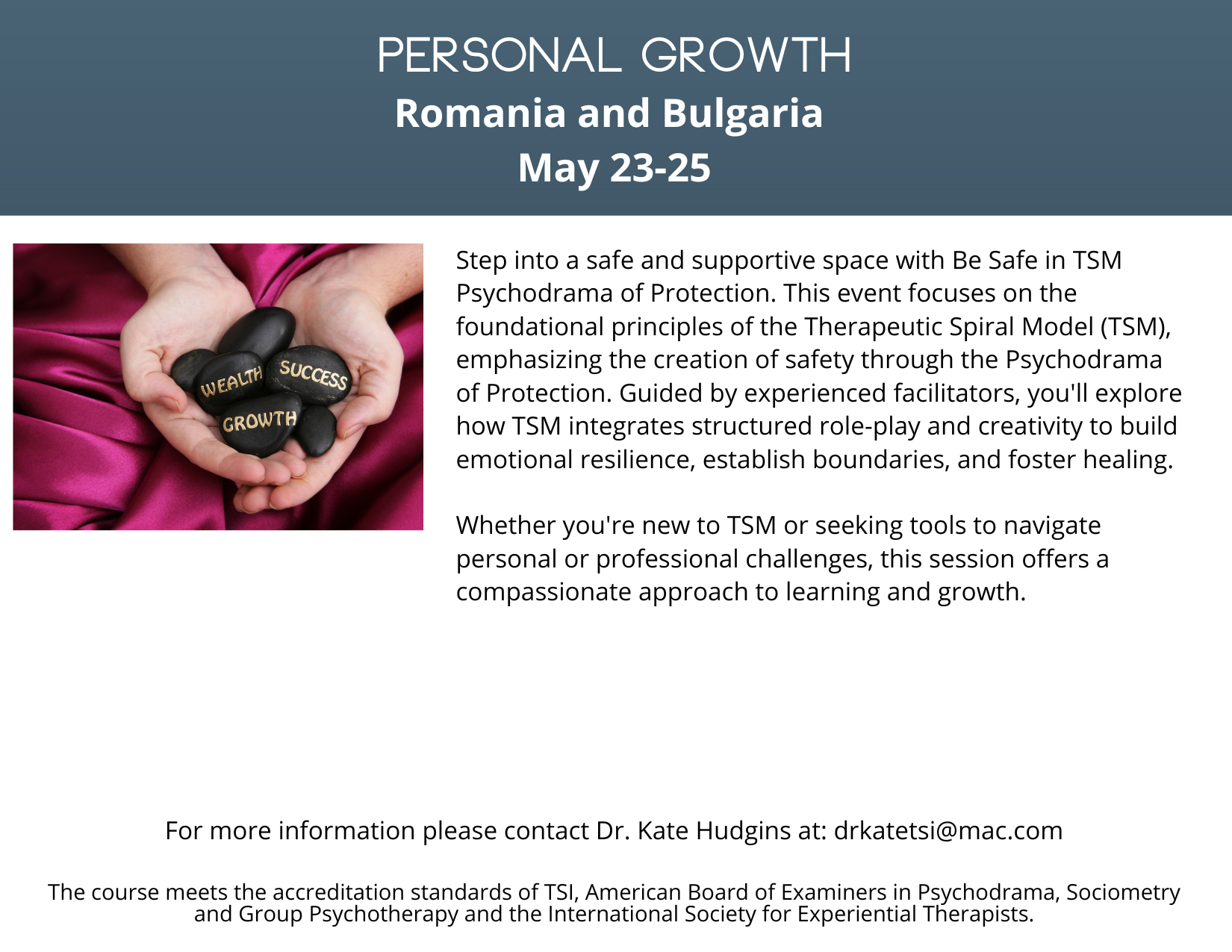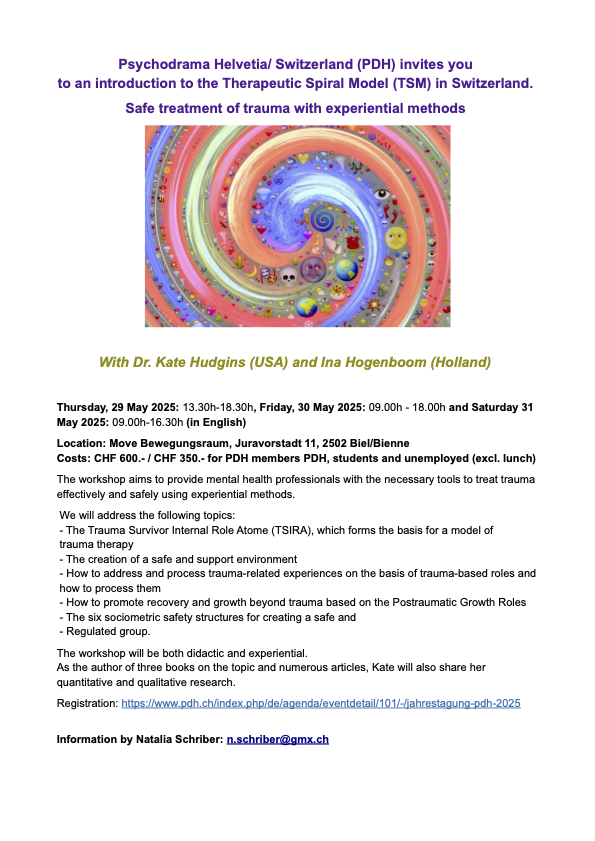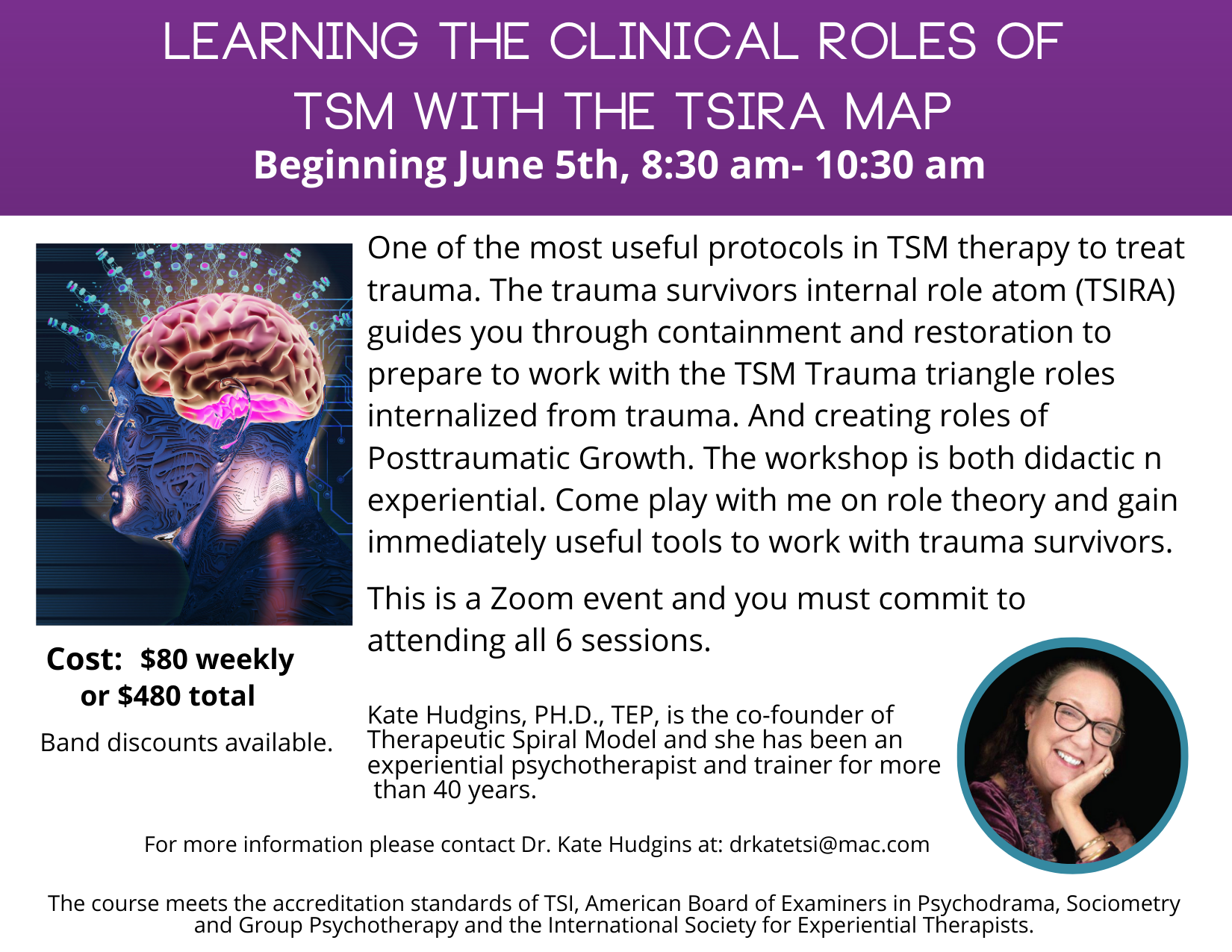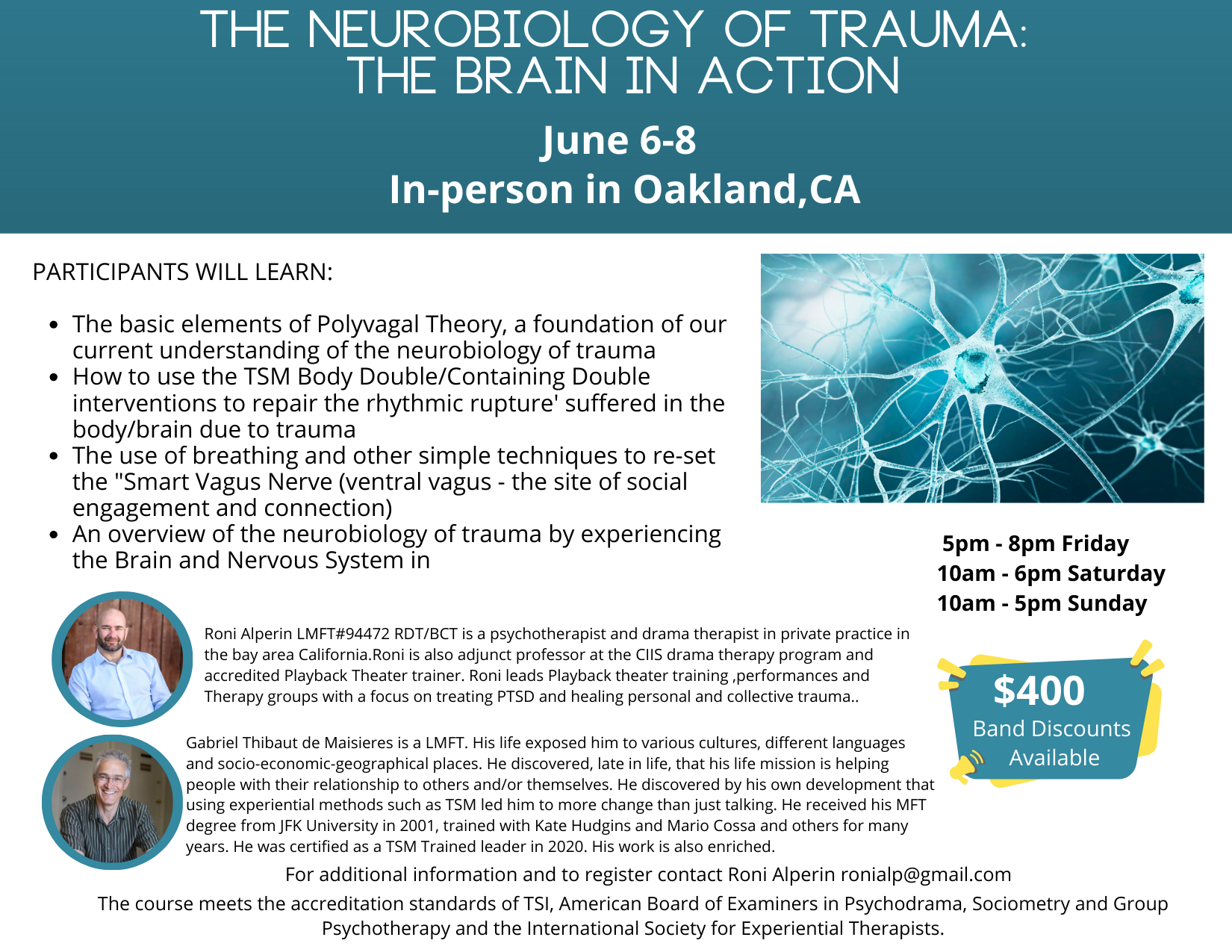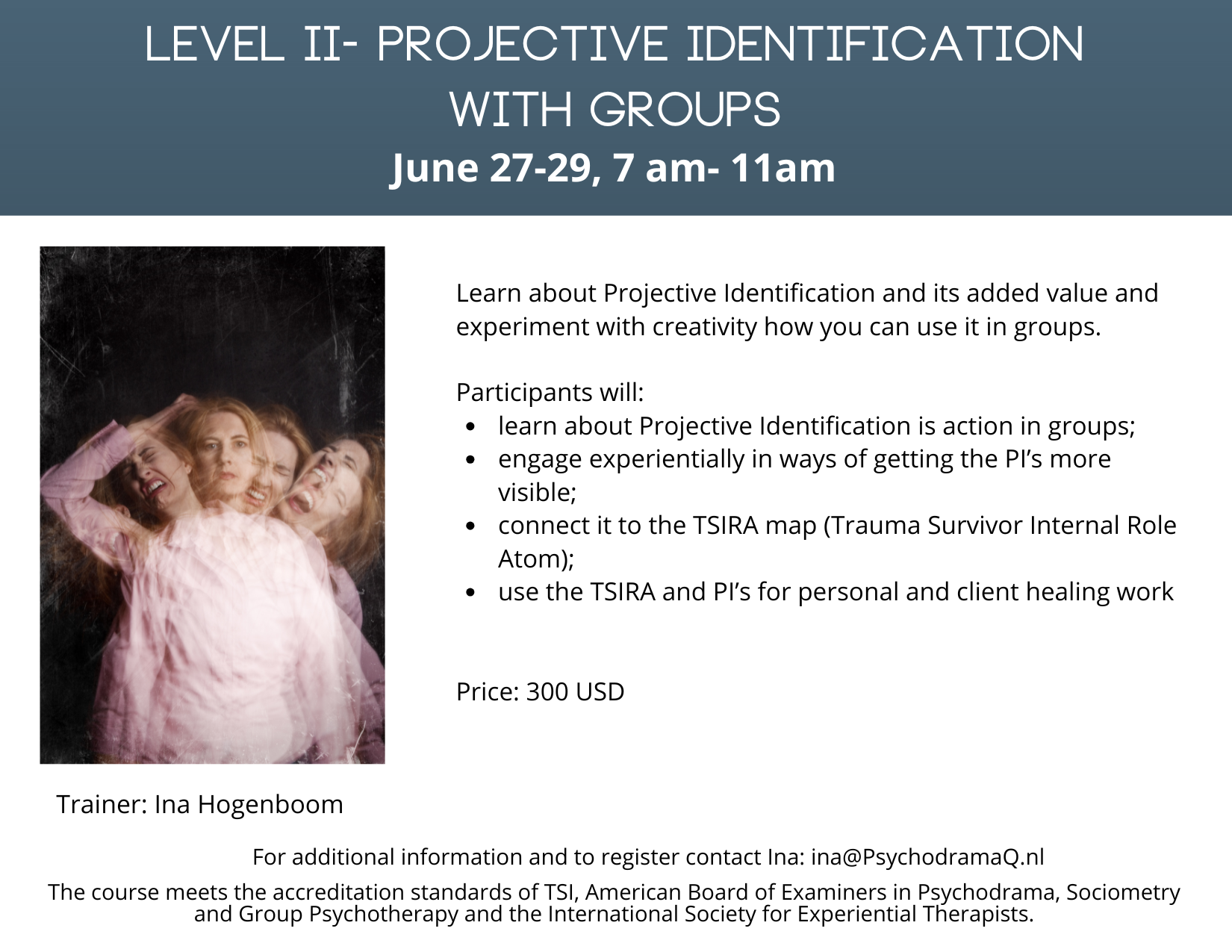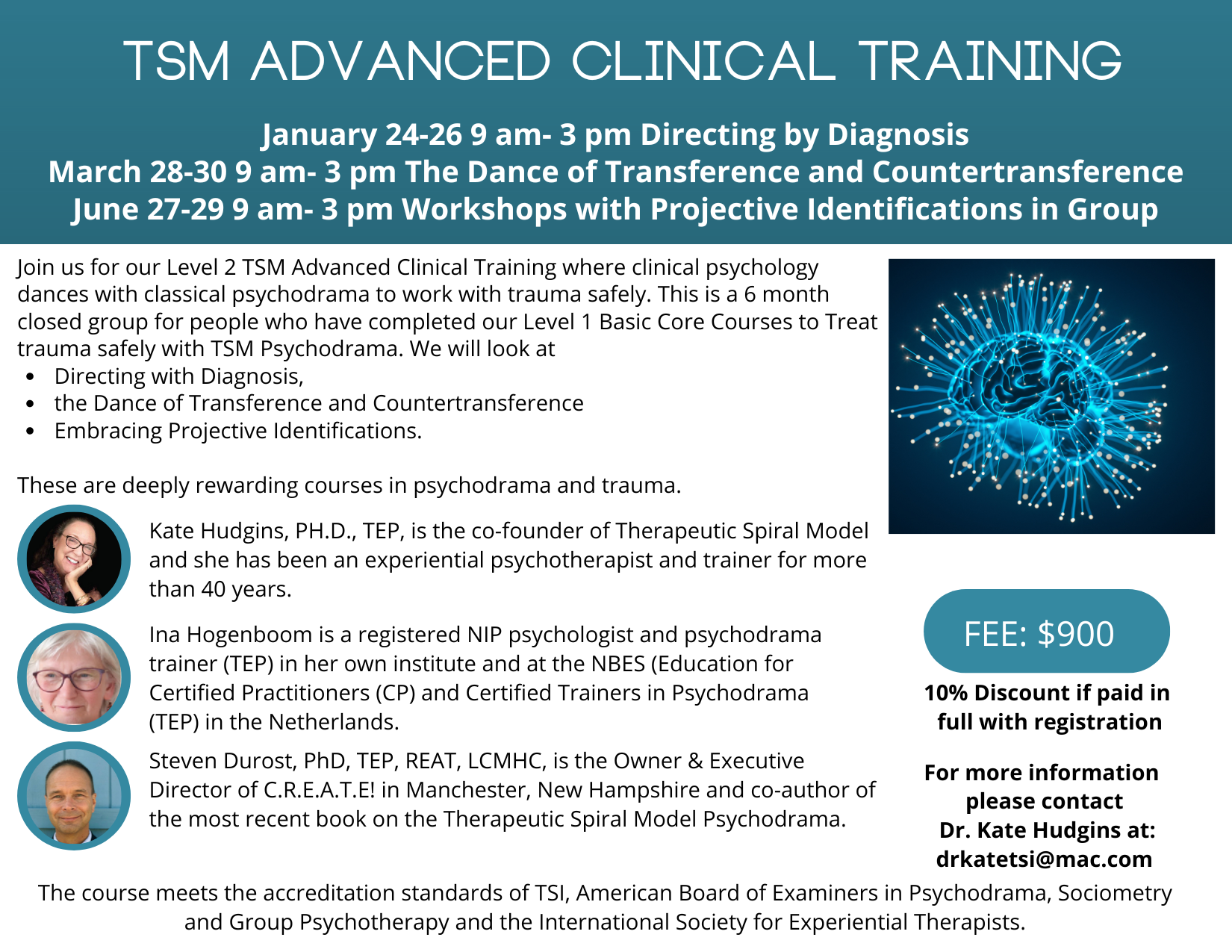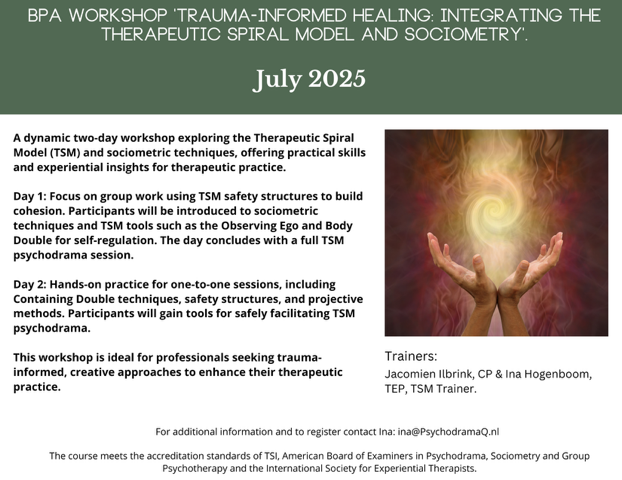Research

Alers V.M. 2008 “The 20th Vona du Toit Memorial lecture 2007. Proposing the social atom of occupational therapy:Dealing with trauma as part of an integrated inclusive intervention.” South African Journal of Occupational Therapy, 38, 3, (3 – 10). http://www.scielo.org.za/scielo.php?script=sci_arttext&pid=S2310-38332008000300003
Alers , V. M. (2013). In Therapeutic spiral model perspective from South Africa—The rainbow nation. essay. Retrieved from https://www.amazon.com/Healing-World-Trauma-Therapeutic-Spiral/dp/1849059233
Alers, V. & Crouch, R. (2014). Trauma and its effects on children, adolescents and adults. Occupational Therapy in Psychiatry and Mental Health, 337-355. doi:10.1002/9781118913536.ch21 http://onlinelibrary.wiley.com/book/10.1002/9781118913536
Alexander, N. & Ciotola, L. (2014).Teamwork and trauma recovery. The Journal of Psychodrama, Sociometry and Group Psychotherapy. Vol 62 (1), 91-104. http://asgppjournal.org/doi/abs/10.12926/0731-1273-62.1.91?code=asgp-site
APA. (n.d.). Diagnostic and statistical manual of mental disorders (5th ed.). Retrieved from https://www.psychiatry.org/psychiatrists/practice/dsm.
https://cdn.website-editor.net/30f11123991548a0af708722d458e476/files/uploaded/DSM%2520V.pdf
American Psychological Assocation. PTSD: National Center for PTSD Comparison of the ICD-10 PTSD Diagnosis With the DSM-IV Criteria -. (n.d.). Retrieved September 02, 2016, from http://www.ptsd.va.gov/professional/assessment/overview/comparison-icd-dsm-iv.asp
Bacallao, M. & Smokowski, P.R. (2017a) Entre Dos Mundos/Between Two Worlds: Using the Acculturation Spectrogram in Psychodrama Intervention for Promoting Biculturalism in Immigrant Families. The Journal of Psychodrama, Sociometry, and Group Psychotherapy 65(1), 41-56 http://asgppjournal.org
Bacallao, M. & Smokowski, P.R. (2017b) Navigating the Web of Worries: Using Psychodrama Techniques to Help Latino Immigrant Families Manage Acculturation Stress. The Journal of Psychodrama, Sociometry, and Group Psychotherapy 65(1), 57-73 http://asgppjournal.org
Baim, C. (2017). ‘Psychodrama,’ in Colin Feltham, Terry Hanley and Laura Ann Winter (Eds.) The Sage Handbook of Counselling and Psychotherapy (4th edition).Los Angeles, CA and London: Sage Publications. https://www.amazon.com/SAGE-Handbook-Counselling-Psychotherapy/dp/1473953316
Baim, C. . (2014). Baim C integrating psychodrama with Attachment theory implications for practice. Scribd., from https://www.scribd.com/document/446801503/Baim-C-Integrating-Psychodrama-with-Attachment-Theory-Implications-for-Practice
Baim, C. (2010). ‘Psychodrama,’ in Irving B. Weiner and W. Edward Craighead (Eds.) The Corsini Encyclopedia of Psychology (4th edition, vol. 3: M-Q). Hoboken, NJ: John Wiley and Sons. https://www.amazon.com/Corsini-Encyclopedia-Psychology-3/dp/0470170271
Baratka, C. (1995). Incorporating Principles of the Therapeutic Spiral Model When an Action Trauma Team is not Available.
Bion, W. R. (2013). Attacks on linking. Retrieved from https://www.tandfonline.com/doi/abs/10.1002/j.2167-4086.2013.00029.x
Blatner, A. (1996). Acting-In: Practical applications of psychodramatic methods (3rd ed.). Retrieved from https://blatner.com/adam/books/Acting-In%20%20Practical%20Applications%20of%20Psychodramatic%20Methods,%20Third%20Edition%20Adam%20Blatner%20MD%20220p_0826114024_B.pdf
Blatner, A. (2004). Psychodrama. In R. J. Corsini & D. Wedding (Eds.), Current psychotherapies (7th ed.). essay, https://assets.pubpub.org/nb4scb4q/e7802bd2-950a-4d80-8b1c-65dbe02006f7.pdf
Bradshaw-Tauvon, K. (2014). Psychodrama informed by adaptive information processing (AIP): The theory underpinnin geye movement desensitization and reprocessing (EMDR). In P. Holmes, M. Farrall, & K. Kirk (Eds) Empowering Therapeutic Practice: Integrating psychodrama into other therapies. London: Jessica Kingsley Publishers https://www.amazon.com/Empowering-Therapeutic-Practice-Integrating-Psychodrama/dp/1849054584
Brederode, A., Levine, E. G., Levine, S. K. (1998). Layer upon layer: A healing experience in the art studio. . In Foundations of Expressive Arts Therapy: Theoretical and clinical perspectives (pp. 151–170). essay, J. Kingsley Publishers.
Buchanan, D. R., & Swink, D. F. (2017). Golden age of psychodrama at Saint Elizabeths Hospital (1939–2004). The Journal of Psychodrama, Sociometry, and Group Psychotherapy, 65(1), 9–32. https://doi.org/10.12926/0731-1273-65.1.9
Burden, K., & Ciotola, L. (n.d.). “The body double: An advanced clinical action intervention module in the therapeutic spiral model to treat trauma”. Healing Bridges. Retrieved from https://healing-bridges.com/2017/07/06/the-body-double/.
Calhoun, L. G., Tedeschi, R. G., & Amir, M. (2014). Handbook of Posttraumatic Growth: Research and Practice. Psychology Press. Retrieved from https://iliff.instructure.com/courses/1257925/files/47248255/download?verifier=49kNaGuA2bLDtYTd6QYPMRhCExV7lpErFxIE9RXX. https://www.taylorfrancis.com/books/edit/10.4324/9781315805597/handbook-posttraumatic-growth-lawrence-calhoun-richard-tedeschi
Carnabucci, K. (2014). Show and Tell Psychodrama: Skills for Therapists, Coaches, Teachers, and Leaders. Racine Wisconsin: Nusanto Publishing. https://www.amazon.com/Show-Tell-Psychodrama-Therapists-Teachers/dp/0615985777
Carnabucci, K. & Ciotola, L. (2013). Healing Eating Disorders with Psychodrama and Other Action Methods: Beyond the Silence and the Fury. London: Jessica Kingsley Publishers https://www.amazon.com/Healing-Eating-Disorders-Psychodrama-Methods/dp/1849059349
Casson, J., Karp, M. , Holmes, P., & Tauvon, K. B. (2005). The stage: The theatre of psychodrama. In The Handbook of Psychodrama (1st edn.). essay. Retrieved from https://www.routledge.com/The-Handbook-of-Psychodrama/Karp-Holmes-Tauvon/p/book/9780415148467. https://www.perlego.com/book/1604241/the-handbook-of-psychodrama-pdf
Ciotola, L. (2017). Action Methods/Psychodrama Archives – Page 2 of 2 – Healing Bridges (healing-bridges.com). Healing Bridges. Retrieved from https://healing-bridges.com/category/psychodrama-and-related-articles/page/2/
Clark, T. L., & Davis-Gage, D. (2010). Treating trauma: Using psychodrama in groups. Retrieved from http://counselingoutfitters.com/vistas/vistas10/Article_59.pdf https://www.counseling.org/docs/disaster-and-trauma_sexual-abuse/treating-trauma_psychodrama-in-groups.pdf?sfvrsn=2
Cossa, M. (2020). Building resilience in youth with Therapeutic Spiral ModelTM (TSM) psychodrama Working with post-high-school youth in Bali, Indonesia https://therapeuticspiralmodel.com/wp-content/uploads/2020/07/2.-cossa2020.pdf
Cossa, M. (2019). Circle of Values: Action Approaches in Indonesian Education. https://therapeuticspiralmodel.com/wp-content/uploads/2019/05/TSI-Website-THE_CIRCLE_OF_VALUES.pdf
Cossa, M. (2012). Mask cards. photograph.
Courtois, C. A. (1988). Healing the incest wound: Adult survivors in therapy. Norton. Retrieved from https://www.amazon.com/Healing-Incest-Wound-Survivors-Professional/dp/0393705471. https://archive.org/details/healingincestwou0000cour_f0r9
Cozolino, L. J. (2010). The Neuroscience of Psychotherapy: Healing the Social Brain. W. W. Norton & Company. Retrieved from https://www.amazon.com/Neuroscience-Psychotherapy-Healing-Interpersonal-Neurobiology/dp/0393706427. https://www.pdfdrive.com/the-neuroscience-of-psychotherapy-healing-the-social-brain-e196425587.html
Cozolino, L. (2014). The Neuroscience of Human Relationships: Attachment and the Developing Social Brain (Second edition). Retrieved from https://www.amazon.com/Neuroscience-Human-Relationships-Interpersonal-Neurobiology/dp/0393707822. https://www.researchgate.net/publication/282453167_THE_NEUROSCIENCE_OF_HUMAN_RELATIONSHIPS_ATTACHMENT_AND_THE_DEVELOPING_SOCIAL_BRAIN_2ND_EDITION_LOUIS_COZOLINO_W_W_Norton_Company_Second_Edition_edition_2014_656_pp_ISBN-10_0393707822_ISBN-13_978-03937
Cozolino, L. J. (2015). Why therapy works: Using our minds to change our brains. W.W. Norton & Company. Retrieved from https://www.amazon.com/Why-Therapy-Works-Interpersonal-Neurobiology/dp/0393709051. https://www.pdfdrive.com/why-therapy-works-using-our-minds-to-change-our-brains-e194701438.html
Dayton, T. (2015). NeuroPsychodrama in the Treatment of Relational Trauma: A Strength-based, Experiential Model for Healing PTSD. Deerfield Beach, FL: Health Communications, Inc. https://www.amazon.com/Neuro-Psychodrama-Treatment-Relational-Trauma-Strength-Based/dp/B0186D86FS
Dayton, T. (2016). Neuropsychodrama in the treatment of relational trauma: Relational trauma repair—An experiential model for treating posttraumatic stress disorder. The Journal of Psychodrama, Sociometry, and Group Psychotherapy, 64(1), 41-50. doi:10.12926/0731-1273-64.1.41. http://www.asgppjournal.org/doi/abs/10.12926/0731-1273-64.1.41
di Pellegrino, G., Fadiga, L., Fogassi, L., Gallese, V., & Rizzolatti, G. (1992). Understanding motor events: A neurophysiological study – experimental brain research. SpringerLink. Retrieved from https://link.springer.com/article/10.1007/BF00230027
Durost, S.W. (2011). Old is an attitude – age is a concept: A qualitative study on aging and ageism with guidelines for expressive therapies literature (dissertation).
Elliott, R., Greenberg, L., and Lietaer, G. (2002). Research on experiential psychotherapy. In M. Lambert, A. Bergin, and S. Garfield (5th Ed.), Handbook of psychotherapy and behavior Change (493-540). New York, NY: Wiley. https://pure.strath.ac.uk/portal/files/7404333/ElliottHand_Pre_2004.pdf
Elliott, R., Watson, J., Greenberg, L.S., Timulak, L., & Freire, E. (2013). Research on humanistic-experiential psychotherapies. In M. Lambert, A. Bergin, and S. Garfield (Eds.), Handbook of psychotherapy and behavior Change. (6th Ed). (pp. 495-538). New York, NY: Wiley.. New York: Wiley. ©Wiley. https://pure.strath.ac.uk/portal/en/publications/research-on-humanisticexperiential-psychotherapies(afa5c6ed-bf18-4d17-a3e0-3965742053ab)/export.html
Forst, M. (2001). The therapeutic spiral model: A qualitive enquiry of its effectiveness in the treatment of trauma and addiction. (thesis).
Forst, M. (2017). Wobble diagram. photograph.
Friedman, M. J. (2015). Overview of Post-traumatic Stress Disorder (PTSD). Post-traumatic and Acute Stress Disorders, (6th Ed) 1-8. doi: 10.1007/978-3-319-15066-6_1 http://www.springer.com/us/book/9783319150659
Gallese, V., Fadiga, L., Fogassi, L., & Rizzolatti, G. (1996, April 1). Action recognition in the premotor cortex. OUP Academic. Retrieved from https://academic.oup.com/brain/article/119/2/593/382476
Gantt, S. P., Badenoch, B., Flores. P. (2013). Group psychotherapy and neuro-plasticity: An attachment theory perspective. In The interpersonal neurobiology of group psychotherapy and group process (1st edition, pp. 51–72). essay, Routledge.
Gantt, S. P., Badenoch, B. (n.d.). The interpersonal neurobiology of group psychotherapy and group process (1st ed.). Retrieved from https://www.amazon.com/Interpersonal-Neurobiology-Group-Psychotherapy-Process/dp/1780491778. https://www.researchgate.net/publication/47620057_Integrating_Interpersonal_Neurobiology_with_Group_Psychotherapy
Gantt, S., Agazarian, Y. (2015). Developing the group mind through functional subgrouping: Linking systems-centered training (SCT) and interpersonal neurobiology. In Badenoch, B. & Gantt, S. P. (Eds.), The interpersonal neurobiology of group psychotherapy and group process (pp. 73–102). essay. Retrieved from https://guilfordjournals.com/doi/10.1521/ijgp.2010.60.4.515
Gelinas, D. J. (1983). The persisting negative effects of incest. Taylor & Francis. Retrieved from https://www.tandfonline.com/doi/abs/10.1080/00332747.1983.11024207
Giacomucci, S. (2021). Social Work, sociometry, and psychodrama. SpringerLink. Retrieved from https://link.springer.com/book/10.1007/978-981-33-6342-7
Giacomucci, S., Maya, J., Maraver, J. (2021). Traumatic stress and spontaneity: Trauma-focused and strength-based psychodrama. In Psychodrama: Advances in psychotherapy and psychoeducational interventions. essay.
Giacomucci, S. (2021). Social Work, sociometry, and psychodrama. SpringerLink. Retrieved from https://link.springer.com/book/10.1007/978-981-33-6342-7
Giacomucci, S., Marquit, J. (2020, April 14). The effectiveness of trauma-focused psychodrama in the treatment of PTSD in inpatient substance abuse treatment. Frontiers. Retrieved from https://www.frontiersin.org/articles/10.3389/fpsyg.2020.00896/full
Greenberg, L. S. (2013). Anchoring the therapeutic spiral model into research on experiential psychotherapies.In K. Hudgins & F. Toscani (Eds.), Healing world trauma with the therapeutic spiral model. (pp. 132-148) London: Jessica Kingsley Publishers. https://www.amazon.com/Healing-World-Trauma-Therapeutic-Spiral/dp/1849059233/ref=sr_1_3?s=books&ie=UTF8&qid=1495655422&sr=1-3&keywords=healing+world+trauma
Greenberg, L. S., Watson, J. C., & Lietaer, G. (1998). Handbook of experiential psychotherapy. New York: Guilford Press.https://www.guilford.com/books/Handbook-of-Experiential-Psychotherapy/Greenberg-Watson-Lietaer/9781572303744/contents
Hale, A. E. (1985). Conducting clinical sociometric explorations: A manual for psychodramatists and sociometrists (1st workbook ed edition). Retrieved from https://library.oapen.org/bitstream/id/7dfed896-c4fb-4c01-95be-664e8dd8bb23/9789813363427.pdf
Hale, A. E., Levine, S. K. (n.d.). Living artfully: Movement as an integrative process. In Levine, E. G. (Ed.), Foundations of expressive arts therapy: Theoretical and clinical perspectives (pp. 133–150). essay. https://www.amazon.com/Foundations-Expressive-Arts-Therapy-Perspectives/dp/1853024635
Herman, J. L. (1997). Trauma and recovery (Rev. ed.). Retrieved from https://www.pdfdrive.com/trauma-and-recovery-judith-herman-m-d-e17694190.html https://www.amazon.com/Trauma-Recovery-Aftermath-Violence-Political/dp/0465087302
Hudgins, K. (2022). Transformación del Triángulo del trauma – TSM. La hoja de psicodrama. Retrieved from http://lahojadepsicodrama.es/wp-content/uploads/lahojadepsicodrama-074-p-06-19-triangulo-trauma.pdf
Hudgins, M.K. (2002). Experiential treatment for PTSD. Springer Publishing Company. Retrieved from https://www.springerpub.com/experiential-treatment-for-ptsd-9780826149428.html
Hudgins, M.K.(2019) Psychodrama Revisited: Through the Lens of the Internal Role Map of the Therapeutic Spiral Model to Promote Post-traumatic Growth. Published online https://therapeuticspiralmodel.com/wp-content/uploads/2020/07/1.-Psychodrama-Revisited_Hudgins-2019.pdf
Hudgins, M.K. (2017) PTSD Unites the World: Prevention, Intervention and Training in The Therapeutic Spiral Model. In C.E. Stout and G. Want (eds).Why Global Health Matters:Guidebook for Innovation and Inspiration. Self-Published Online. https://www.whyglobalhealthmatters.org
Hudgins, K. (2013). The similarities and differences between classical psychodrama and the therapeutic spiral model. In Toscani, F. (Ed.), Healing world trauma with the therapeutic spiral model: Psychodramatic stories from the frontlines (pp. 49–74). essay. http://www. 123library.org/book_details/?id=58841 https://books.google.com.eg/books?id=sjZiLC5kKDkC&pg=PA354&lpg=PA354&dq=Healing+World+Trauma+with+the+Therapeutic+Spiral+Model+online+free&source=bl&ots=40oRfOVvb5&sig=ACfU3U2a4ZpqFJ3JFdyxScQFEgpTHkk9Xg&hl=en&sa=X&ved=2ahUKEwijw7WxoLD4AhVEi_0HHSZECGUQ6AF6BAgTEAM#v=onepage&q=Healing%20World%20Trauma%20with%20the%20Therapeutic%20Spiral%20Model%20online%20free&f=false
Hudgins, M. K. (1998). Defenses workshop handout.
Hudgins, K., Brooke, S. L., Myers, C. E.(2015). Spiral healing: A thread of energy and connections across cultures. In Therapists creating a cultural tapestry: Using the creative therapies across cultures. essay, Charles C Thomas, Publisher, Ltd. https://www.tandfonline.com/doi/abs/10.1080/08098131.2016.1250806
Hudgins, M.K. (2007b). Clinical Foundations of the Therapeutic Spiral Model: Theoretical Orientations and Principles of Change. (eds) In C. Baim, J. Burmeister & M. Maciel (Eds.) Psychodrama: Advances in Theory and Practice. (pp. 175-188) London: Routledge. https://www.amazon.com/Psychodrama-Advances-Practice-Advancing-Therapy/dp/
Hudgins, M.K. & Drucker, K. (1998). The containing double as part of the therapeutic spiral model for treating trauma survivors. The International Journal of Action Methods, 51, 2, 63-74. http://connection.ebscohost.com/c/articles/1974431/containing-double-as-part-therapeutic-spiral-model-treating-trauma-survivors
Hudgins, M.K., Drucker, K., & Metcalf, K. (2000). The containing double: A clinically effective psychodrama intervention for PTSD. The British Journal of Psychodrama and Sociodrama, 15, 1, 58-77. http://drkatehudgins.com/yahoo_site_admin1/assets/docs/Containing_DoubleBPA_Article.173173224.pdf
Hudgins, K., Durost, S. W., Honig, M. (n.d.). Therapeutic spiral model psychodrama around the world: Cultural connections. In Taboada, C. M. (Ed.), IAGP transcultural book working with cultural diversity. essay.
Hudgins, M. K., Hug, E., Culbertson, R. (2009). Action against trauma: A trainer’s manual. https://www.lulu.com/en/gb/shop/hudgins-culbertson-and-hug-/action-against-trauma-a-trainers-manual/ebook/product-1wzdyp85.html?page=1&pageSize=4
Hudgins, K., Kellermann, P. F. (2000). Psychodrama with trauma survivors: Acting out your pain – researchgate. Retrieved from https://www.researchgate.net/publication/287571213_Psychodrama_with_Trauma_Survivors_Acting_out_your_pain Psychodrama with trauma survivors: Acting out your pain. 229–254
Hudgins, M.K., and Kiesler, D.J. (1987). Individual experiential psychotherapy: An initial validation study of the intervention module of psychodramatic doubling. Psychotherapy, 24, 245-255. http://psycnet.apa.org/index.cfm?fa=buy.optionToBuy&id=1988-02002-001
Hudgins, M.K. & Kiesler, D.J. (1985). Individual Experiential Psychotherapy: An Initial Validation Study of the Intervention Module of Psychodramatic Doubling. Unpublished Dissertation. Virginia Commonwealth University.
Hudgins, M.K. and Kiesler, D.J. (1984). Instructional Manual for Doubling in Individual Psychotherapy. Richmond, Virginia: Virginia Commonwealth University.
Hudgins, M.K. & Preston, J.C. (1981). Psychodramatic expansion of the Johari window. Journal of Group Psychotherapy, Psychodrama, and Sociometry http://www.drkatehudgins.com/yahoo_site_admin1/assets/docs/Kates_vita_2016.114161626.docx
Hudgins, M.K., Drucker, K., & Metcalf, K.. (1998). Instructional Manual for the intervention module of Containing Double. Charlottesville, VA.: The Center for Experiential Learning. http://www.ibrarian.net/navon/paper/The__Containing_Double A_clinically_effective_.pdf?paperid=765781
Hudgins, K., Sheridan, M. J. (1990). The three-child model of recovery.
Hudgins, K. & Toscani, F. (2014). Containment = Safety with action methods. The Journal of Psychodrama, Sociometry and Group Psychotherapy, 62, (1), 105-110. http://www.asgppjournal.org/doi/abs/10.12926/0731-1273-62.1.105
Hudgins, K. & Toscani, F. (2013). Healing World Trauma with The Therapeutic Spiral Model: Stories From the Frontlines. London: Jessica Kingsley Publishers. https://www.amazon.com/Healing-World-Trauma-Therapeutic-Spiral/dp/1849059233
Hug, E. (2013). A Neuroscience perspective on trauma and action methods. In K. Hudgins, & F. Toscani (Eds.), Healing world trauma with the therapeutic spiral model. London: Jessica Kingsley Publishers. https://www.amazon.com/Healing-World-Trauma-Therapeutic-Spiral/dp/1849059233
Forssmann-Falck, R.F. and Hudgins, M.K. (1992). “Therapist-Patient Transactions Early in Treatment with Borderline Patients. Clinical Review, 6, (1), 1-4.
Israel, S. (2019) Integrated Care for the Traumatized. The Therapeutic Spiral Model: A Psychodramatic Whole Person Approach for Working with Trauma. Rowan.com
Israel, S. (2016). The containing double sequence: An expansion of the therapeutic spiral model.
Jiliberto Herrera, A., Hudgins, K. (2022, July 27). Hablando con Kate Hudgins. La Hoja de Psicodrama. Revista de la Asociación Española de Psicodrama. Retrieved from http://lahojadepsicodrama.es/hablando-con-kate-hudgins/
Johnson, D. R. (1998). Apa PsycNet. American Psychological Association. Retrieved from https://psycnet.apa.org/record/1985-31427-001
Karpman, S. (1968). Fairy tales and script drama analysis – karpman drama triangle. Transactional Analysis Bulletin. Retrieved from https://karpmandramatriangle.com/pdf/DramaTriangle.pdf
Kellermann, P. F. (1992). Focus on psychodrama: The therapeutic aspects of psychodrama – researchgate. Retrieved from https://www.researchgate.net/publication/287204887_Focus_on_Psychodrama_The_Therapeutic_Aspects_of_Psychodrama
Keltner, D., Ekman, P. (2015, July 3). The science of ‘inside out’. The New York Times. Retrieved from https://www.nytimes.com/2015/07/05/opinion/sunday/the-science-of-inside-out.html
Kinnell, G. (1980, January 1). Mortal acts, mortal words (1980 edition). Open Library. Retrieved from https://openlibrary.org/books/OL4423017M/Mortal_acts_mortal_words
Klein, M. (1946). Klein notes on some schizoid mechanisms – freudians.org. Retrieved from http://freudians.org/wp-content/uploads/2014/09/Klein-Notes-on-Some-Schizoid-Mechanisms.pdf
Knill, P. J., Levine, E. G., Levine, S. K. (1999). Soul nourishment, or the intermodal language of imagination. Foundations of Expressive Arts therapy – theoretical and Clinical Perspective PDF. Retrieved from https://www.scribd.com/document/372301332/Foundations-of-Expressive-Arts-Therapy-Theoretical-and-Clinical-Perspective-pdf pp. 37–52
Laat, P. de. (2005). Psychodrama: 9789023241843: P. De Laat: Boeken. Psychodrama | 9789023241843 | P. de Laat | Boeken. Retrieved from https://www.bol.com/nl/nl/p/psychodrama/1001004002632815/
Lai, N.W., (2013). A workshop using the therapeutic spiral model and art therapy with mothers and children affected by domestic abuse in Taiwan In K. Hudgins, & F. Toscani, Healing world trauma with the therapeutic spiral model, (241-265). London: Jessica Kingsley. https://www.amazon.com/Healing-World-Trauma-Therapeutic-Spiral/dp/1849059233/ref=sr_1_3?s=books&ie=UTF8&qid=1495548889&sr=1-3&keywords=healing+world+trauma
Lane, R. D., Ryan, L., Nadel, L., & Greenberg, L. (2005). Memory reconsolidation, emotional arousal, and the process of change in psychotherapy: New insights from brain science: Behavioral and brain sciences. Cambridge Core. Retrieved from https://www.cambridge.org/core/journals/behavioral-and-brain-sciences/article/abs/memory-reconsolidation-emotional-arousal-and-the-process-of-change-in-psychotherapy-new-insights-from-brain-science/D7E4F9A5AA0A1720AAED287B29419D4B
Lawrence, C. (2015). The Caring Observer: Creating Self-Compassion Through Psychodrama. The Journal of Psychodrama, Sociometry, and Group Psychotherapy 63(1): 65-72 http://asgppjournal.org/doi/10.12926/0731-1273-63.1.65
Levine, E. G., Levine, S. K. . (1999). On the playground: Child psychology and expressive arts therapy. Foundations of expressive arts therapy: Theoretical and clinical perspectives. Retrieved from https://www.scribd.com/document/372301332/Foundations-of-Expressive-Arts-Therapy-Theoretical-and-Clinical-Perspective-pdf pp. 257–273
Levine, P. A. (2015). Trauma and Memory: Brain and Body in a Search for the Living Past: A Practical Guide for Understanding and Working with Traumatic Memory. Retrieved from https://zlibrary.to/pdfs/trauma-and-memory-brain-and-body-in-a-search-for-the-living-past-pdf
McVea, C. and Gow, K. (2006). Healing a mother’s emotional pain: Recall of a therapeutic spiral model session. Journal of Psychodrama, Group Psychotherapy and Sociometry, 59, 1, 3-2 http://eprints.qut.edu.au/21966/
McVea, C., Gow, K., and Lowe, R. (2011). Corrective interpersonal experience in psychodrama group psychotherapy: A comprehensive process analysis of significant therapeutic events. Psychotherapy Research, 21, 4, 416-429. http://www.tandfonline.com/doi/abs/10.1080/10503307.2011.577823
Megele, C. (2015, July 5). The role of emotional labour, mentalization, empathy & mindfulness in practice education. Academia.edu. Retrieved from https://www.academia.edu/13656673/The_Role_of_Emotional_Labour_Mentalization_Empathy_and_Mindfulness_in_Practice_Education
Meichenbaum, D. (2017). A constructive narrative perspective on trauma and resilience: The role … Retrieved from https://www.melissainstitute.org/documents/Conf19-4-2015-role-of-cognitive.pdf
Miller, D. (1992). Are we keeping up with Oprah? Taylor & Francis. Retrieved from https://www.tandfonline.com/doi/abs/10.1300/J086v03n03_07
Molnar-Szakacs, I., Overy, K. (2006). Music and mirror neurons: From motion to ’e’motion. Academic.oup.com. Retrieved from https://academic.oup.com/scan/article/1/3/235/2362883
Moreno, J. L. (1934). Who shall survive?: A new approach to the problem of human interrelations. Retrieved from https://reflexus.org/wp-content/uploads/whoshallsurvive.pdf
Moreno, J. L. (1993). Who shall survive? foundations of sociometry, group psychotherapy and Sociodrama. Journal of the American Medical Association. Retrieved from https://jamanetwork.com/journals/jama/article-abstract/289925
Moreno, J. L., Moreno, Z. T. (1959). Psychodrama ; Second Volume: Foundations of psychotherapy. Amazon. Retrieved from https://www.amazon.com/Psychodrama-Second-Foundations-Psychotherapy-Moreno/dp/B000MURKPG
Moreno, J. L., Moreno, Z. T. (1969). Psychodrama. Beacon House.
Moreno, Z., Hudgins, K., Toscani, F., Blatner. (2012, December 15). A life in psychodrama. 123Library. Retrieved from https://www.123library.org/ebook/id/58841/ Healing world trauma with the therapeutic spiral model: Psychodramatic stories from the frontlines. pp. 33–48
Moreno, Z. T., Horvatin, T. , Schreiber, E. (2006). The function of “Tele” in human relations. . Perlego. Retrieved from https://www.perlego.com/book/1615952/the-quintessential-zerka-writings-by-zerka-toeman-moreno-on-psychodrama-sociometry-and-group-psychotherapy-pdf The quintessential Zerka: Writings by Zerka Toeman Moreno on psychodrama, sociometry and group psychotherapy (First issued in paperback, pp. 289–301).
Moreno, Z.T. (2012). To Dream Again: A Memoir. Retrieved from https://www.amazon.com/To-Dream-Again-A-Memoir/dp/0979434173
Myers, M. A., Levine, S. K., Levine, E. G. (2000). In exile from the body: Creating a “play room” in the “waiting room. Foundations of Art Therapy Theory and Applications. Amazon. Retrieved from https://www.amazon.com/Foundations-Expressive-Arts-Therapy-Perspectives/dp/1853024637 (pp. 241–256).
Newham, P., Levine, S. K., Levine, E. G. , (2001). Voicework as therapy: The artistic use of singing and vocal sound to heal mind and body. Foundations of Expressive Arts therapy – theoretical and Clinical Perspective PDF. Scribd. Retrieved from https://www.scribd.com/document/372301332/Foundations-of-Expressive-Arts-Therapy-Theoretical-and-Clinical-Perspective-pdf (pp. 89–112)
Noice, H., Noice, T. (2009). An arts intervention for older adults living in subsidized retirement homes. Taylor & Francis. Retrieved from https://www.tandfonline.com/doi/abs/10.1080/13825580802233400
Nolte, J. (2014). The philosophy, theory and methods of J. L. Moreno: The man who tried to become god (1st ed.). Retrieved from https://www.researchgate.net/publication/303599534_The_Philosophy_Theory_and_Methods_of_J_L_Moreno_The_Man_Who_Tried_to_Become_God_By_John_Nolte_The_Philosophy_Theory_and_Methods_of_J_L_Moreno_The_Man_Who_Tried_to_Become_God_By_John_Nolte_Routledge_20
Nolte, J. (2020). J.L. Moreno and the psychodramatic method: On the practice of psychodrama. Retrieved from https://www.researchgate.net/publication/336328120_J_L_Moreno_and_the_Psychodramatic_Method_On_the_Practice_of_Psychodrama.
Nugent, C., Brady, P., (2022) Bridging Two Worlds: Coaching And Psychodrama https://thechallengecoach.com/product/book-bridging-two-worlds-coaching-and-psychodrama
Ogden, T. H. (1979). On projective identification. International Journal of Psychoanalysis. Retrieved February 28, 2023, from http://www.sakkyndig.com/psykologi/artvit/ogden1979.pdf
Orkibi, H., Feniger-Schaal, R. (n.d.). Integrative systematic review of psychodrama psychotherapy research: Trends and methodological implications. Retrieved from https://journals.plos.org/plosone/article?id=10.1371/journal.pone.0212575.
Panksepp, J. (1998). The periconscious substrates of consciousness: Affective states and the evolutionary origins of the self. Retrieved from https://psycnet.apa.org/record/1998-03017-003.
Payne, P., Crane-Godreau, M.A., & Levine, P.A. (2015). Somatic experiencing: Using interoception and proprioception as core elements of trauma therapy. Frountiers in Psychology. Retrieved from https://www.frontiersin.org/articles/10.3389/fpsyg.2015.00093/full
Perry, R., Saby, K., Wenos, R., Hudgins, K. and Baller, M. (2016). Psychodrama intervention for female service members using the therapeutic spiral model. The Journal of Psychodrama, Sociometry, and Group Psychotherapy, 64, 1, 11-23. http://www.asgppjournal.org/doi/abs/10.12926/0731-1273-64.1.11?code=asgp-site
Perry, R., Baller, M., Hudgins, K., Wenos, R., Saby, K. (2021). Social Work, Sociometry, and Psychodrama. Retrieved from https://link.springer.com/book/10.1007/978-981-33-6342-7
Perry, R., Baller, S., Hudgins, K., Wenos, J., Saby, K. (2016). Psychodrama intervention for female service members using the therapeutic spiral model. Retrieved from https://www.researchgate.net/publication/303599457_Psychodrama_Intervention_for_Female_Service_Members_Using_the_Therapeutic_Spiral_Model
Porges, S. W. (2017). The pocket guide to the polyvagal theory: The transformative power of feeling safe (Illustrated edition). Retrieved from https://www.amazon.com/Pocket-Guide-Polyvagal-Theory-Transformative/dp/0393707873
Propper, H. (2018). Practical sociometry: Directing spectograms and locograms. Retrieved from https://dramario.net/wp-content/uploads/2018/01/Spectro-gramand-Locogram-Eng.pdf
Ragsdale, K.G., Cox, R.D., Finn, P. and Eisler, R.M. (1996). Effectiveness of short-term specialized inpatient treatment for war related posttraumatic stress disorder: A role for adventure-based counseling and psychodrama. Journal of Traumatic Stress, 9, 269-283. https://www.ncbi.nlm.nih.gov/pubmed/8731547
Rausch, S.L., van der Kolk,B., Fishler, R.E., Alpert, N.M. et al. (1996). A symptom provocation study of post-traumatic stress disorder using positron emission tomography and script- driven imagery. Archives of General Psychiatry 53,5, 380-387 https://www.ncbi.nlm.nih.gov/pubmed/8624181
Rogers, N. (n.d.). The Creative Connection: Expressive Arts as Healing. Retrieved from https://www.researchgate.net/publication/261684550_The_Creative_Connection_Expressive_Arts_as_Healing
Schore, A. N. (2002). Clinical implications of a psychoneurobiological model of projective identification. In Alhanati, S. (Ed.), Primitive Mental States, Volume 2: Psychobiological and Psychoanalytic Perspectives on Early Trauma and Personality Development (pp. 1–65). essay. Retrieved from https://www.tandfonline.com/doi/abs/10.1080/13698030308401692
Schore, A. (2021, February 28). Affect regulation and the repair of the self. Journal of the American Academy of Child & Adolescent Psychiatry. Retrieved from https://www.academia.edu/45262427/Affect_Regulation_and_the_Repair_of_the_Self
Schore, A. N., Minde, K. (2006, May). Affect dysregulation and disorders of the self. Journal of the Canadian Academy of Child and Adolescent Psychiatry. Retrieved from https://www.ncbi.nlm.nih.gov/pmc/articles/PMC2277284/
Schreiber, E., Sadock, B. J. , Sadock, V. A. , Ruiz, P. , Kaplan, H. I. . (2009). Psychodrama, sociometry, sociodrama, and sociatry. In Kaplan & Sadock’s comprehensive textbook of psychiatry (9th ed.) (pp. 2952–2957). essay. Retrieved from https://www.amazon.com/Kaplan-Sadocks-Comprehensive-Textbook-Psychiatry/dp/1451100477
Schreiber, E. (2019). Sociatry: A tool to heal society and reveals the godhead. Expanding horizons: Using action methods to join all humanity, Dallas, Texas.
Schreiber, E. J., Barcroft, A. (n.d.). The enlightenment tradition of Jacob Levy Moreno and the legacy of sociatry. In Linden, S. B. (Ed.), The heart and soul of psychotherapy: A transpersonal approach through theater arts, drama therapy—Psychodrama—Transformational theater. essay.
Siegel, D. J. (2010). Mindsight: The New Science of Personal Transformation. Retrieved from https://www.researchgate.net/publication/47620064_Mindsight_The_New_Science_of_Personal_Transformation_by_Daniel_J_Siegel_MD_New_York_Bantam_Books2010_336_pp_2700
Siegel, D. J. (2012). The developing mind, second edition: how relationships and the brain interact to shape who we are (2nd ed.). Retrieved from https://www.amazon.com/Developing-Mind-Second-Relationships-Interact/dp/146250390X
Siegel, D. J. (2012). Pocket Guide to Interpersonal Neurobiology: An Integrative Handbook of the Mind. Retrieved from https://www.academia.edu/9043890/Pocket_guide_to_interpersonal_neurobiology_An_integrated_handbook_of_the_mind
Thys, M. (2015). Projectieve identificatie tussen doodsdrift en intersubjectiviteit. Retrieved from https://www.tijdschriftvoorpsychoanalyse.nl/inhoud/tijdschrift_artikel
Tomasulo, D. J. (2020). Learned hopefulness. Retrieved from https://www.amazon.com/Learned-Hopefulness-Harnessing-Positivity-Depression/dp/168403468X
Toscani, F. (1993). The containing double.
Toscani, F. (1994). Wholeness of the action trauma team.
Toscani, F. (1994). The trauma survivor’s intrapsychic role atom. Retrieved from https://www.researchgate.net/publication/334900050_Trauma_Survivor’s_Inner_Role_Atom_A_Clinical_Map_for_Posttraumatic_Growth
Toscani, F., Hudgins, M. K. (1998). The containing double.
Van der Kolk, B. (1991). Childhood traumas: An outline and overview. the american journal of psychiatry. Retrieved from https://ajp.psychiatryonline.org/doi/10.1176/ajp.148.1.10?url_ver=Z39.88-2003&rfr_id=ori:rid:crossref.org&rfr_dat=cr_pub%20%200pubmed
Van der Kolk, B. (1993). Lost in familiar places: creating new connections between the individual and society (Reissue ed.). Retrieved from https://www.amazon.com/Lost-Familiar-Places-Connections-Individual/dp/0300057873
Van der Kolk, B. A. (2002). Posttraumatic therapy in the age of neuroscience. Taylor & Francis. Retrieved from https://www.tandfonline.com/doi/abs/10.1080/10481881209348674
Van der Kolk, B. (2006). Clinical implications of neuroscience in PTSD. Annals of the New York Academy of Sciences,1071(1), 277-293, http://www.traumacenter.org/products/pdf_files/nyasf.pdf
Van der Kolk, B. A. (2014). The body keeps the score: Brain, mind, and body in the healing of trauma. New York,NY: Viking. https://www.amazon.com/Body-Keeps-Score-Healing-Trauma/dp/0143127748
Wald, J. (2003). Clinical art therapy with older adults. Handbook of art therapy. Retrieved from http://www.art-therapy.gr/images/stories/book_library/books/art_therapy/handbook_of_artherapy.pdf
White, J. L., Fodor, K. E., Unterhitzenberger, J., Chou, C., Kartal, D., Leistner, S., Alisic, E. (2014). Is traumatic stress research global? A bibliometric analysis. Retrieved August 23, https://www.ncbi.nlm.nih.gov/pmc/articles/PMC3930940/
Wieser, M. (2007). Studies on treatment effects of psychodrama psychotherapy. In C. Baim, Clark, J. Burmeister, & M. Maciel, Manuela (Eds.). (2007). Psychodrama: Advances in theory and practice (pp. 271-292). New York: Routledge/Taylor & Francis Group. https://www.amazon.com/Psychodrama-Advances-Practice-Advancing-Therapy/dp/041541914X
Wieser, M. (2011). Studies on Treatment Effects of Psychodrama Psychotherapy. In C. M. D. Sales, G. Moita, & J. Frommer (Eds.), Methodological Diversity in Psychotherapy and Counselling Research: Qualitative-Quantitative Approach. 1st International Summer School for Psychotherapy and Counseling Research – Proceedings (pp. 37-40, 111-124). Lisbon: Universidade Autónoma de Lisboa. Retrieved from https://www.researchgate.net/publication/215867545_Studies_on_Treatment_Effects_of_Psychodrama_Psychotherapy
Winnicott, D. W. (2021). The child, the family, and the outside world. Retrieved from https://www.amazon.com/Child-Family-Outside-Classics-Development/dp/0201632683







